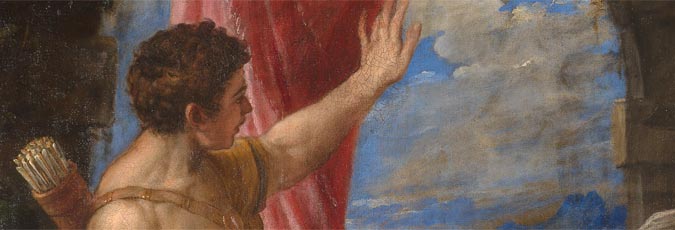History of ownership
Diana and Actaeon and 'Diana and Callisto' were probably first sent to Toledo, where the king was in residence and then to the Royal Palace – the Alcázar – in Madrid when the court moved there in May 1561. In 1623, they almost came to Britain when they were packed up as diplomatic gifts for Prince Charles of England and Scotland (soon to become King Charles I), who was in Madrid to woo the Spanish Infanta, but negotiations foundered and the pictures remained in Madrid.
By 1626 the mythologies were in the king’s summer apartment on the ground floor of the palace, where they were admired by the great collector and polymath Cassiano dal Pozzo. Cassiano noted that every time the queen passed through this apartment, these nude figure paintings had to be covered up in advance. In the middle of the 17th century under the direction of Diego Velázquez, the 'poesie' were moved to a more accessible, formal picture gallery in another part of the palace.
In 1704 Philip V presented the two paintings to the French ambassador and by about 1706–8 they had passed into the incomparable collection of the Duc d’Orléans at the Palais Royal in Paris, where they remained until the French Revolution. They were transported to London in 1793 and bought by Francis Egerton, 3rd Duke of Bridgewater (1736–1803) and two other noblemen, the duke’s nephew and heir Lord Gower (George Granville Leveson-Gower), later 2nd Marquess of Stafford and eventually 1st Duke of Sutherland (1758–1833), and the latter’s brother-in-law, Frederick, 5th Earl of Carlisle (1748–1825). These three owners put the paintings up for sale between December 1798 and July 1799 but retained many for themselves. 'Diana and Actaeon' and 'Diana and Callisto' were reserved for the Duke of Bridgewater.
The Bridgewater and Stafford portions were amalgamated on the death of the Duke of Bridgewater in the collection of Lord Gower, and hung together in his London residence, Cleveland House, off Pall Mall. On Lord Gower’s death in 1833, the Bridgewater Collection passed to his second son Francis Leveson-Gower, who took the name Egerton in 1833, and was made 1st Earl of Ellesmere in 1846.
Cleveland House was remodelled for him by Charles Barry between 1846 and 1854, and the new rooms included a grand picture gallery to house the spectacular collection. It subsequently became known as Bridgewater House. The paintings remained on display there until towards the end of the Second World War when they were removed and lodged on long-term loan at the National Gallery of Scotland from 1945.

